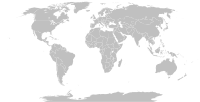|
UCI Road World Cup
The UCI Road World Cup was a season-long road cycling competition held from 1989 until 2004 and comprising ten one-day events. The World Cup was made up of around ten one-day races chosen from the prestigious classics. An individual classification and a team classification were established. In the last editions, the first 25 in each round scored from 100 to 1 points. During these events, the provisional leader of the classification wore a distinctive jersey. History The competition was inaugurated in 1989, and replaced the Super Prestige Pernod International. In the first three years, the competition was sponsored by Perrier. The competition determined a winning individual, and a winning team. In 1989, the classics making up the World Cup were: Milan–San Remo, Tour of Flanders, Paris–Roubaix, Liège–Bastogne–Liège, Amstel Gold Race, Wincanton Classic (Newcastle), Grand Prix of the Americas (Montreal), Clásica de San Sebastián, Züri-Metzgete, Grand Prix de la Liberation (Team Time Trial in Eindhoven), Paris-Tours, Giro di Lombardia. In 1990, a final individual time trial was added in Lunel. In 1991, this time trial was contested in Bergamo (event counting as both the Grand Prix des Nations and the Trofeo Baracchi). In 1992, the Grand Prix de la Liberation disappeared from the World Cup events. The Grand Prix of the Americas becomes the Grand Prix Téléglobe (it will disappear from the World Cup events the following year). That same year, the final time trial was definitively replaced by the Grand Prix des Nations, contested in Palma de Mallorca . In 1993, the Grand Prix des Nations was contested at Lac de Madine. He will disappear from the World Cup events the following year. In 1994, the Wincanton Classic became the Leeds International Classic. In 1995, a new event was added to the calendar: the Frankfurt Grand Prix. It will be its only year as a World Cup event, just like the Japan Cup in 1996. In 1997, the Leeds International Classic became the Rochester Classic. The following year it was replaced by the HEW Cyclassics in Hamburg . From that year, the 10 classics making up the World Cup are therefore: Milan-San Remo, Tour of Flanders, Paris-Roubaix, Amstel Gold Race, Liège-Bastogne-Liège, Hamburg Hew Cyclassics, Clásica de San Sebastián, Züri-Metzgete, Paris-Tours, Giro di Lombardia. The World Cup disappeared with the creation of the ProTour and the continental circuits in 2005. The record number of wins was Paolo Bettini's three consecutive wins in 2002, 2003, and the last edition in 2004. Three riders won the competition twice: Maurizio Fondriest (1991 and 1993), Johan Museeuw (1995 and 1996) and Michele Bartoli (1997 and 1998). The competition was run in parallel to the UCI Road World Rankings, which included all UCI sanctioned events. Both were replaced at the end of the 2004 season with the inauguration of the UCI ProTour and UCI Continental Circuits. Points distributionIndividualPoints are awarded for the best riders in each race according to the following scale: From 1997, the rider in order to be taken into account in the final general classification, must participate in at least six of the 10 races.
TeamsA ranking of the teams has also been set up. During each race, the places of the first three riders of each team are added together. The team with the lowest total receives 12 points in the team standings, the second team receives nine, the third team receives eight and so on until the tenth team scores a point. From 1997, the team in order to be taken into account in the final general classification, must participate in at least eight of the 10 races. RacesThe races with grey background existed but was not in the World Cup calendar for that year
The final time trial (1990-1993) was an invitation event. The invited riders are the single Cup race winners, the first 10 of the general classification before the last race, the first 10 in the World Ranking and the reigning World Champion. Generally some riders forfeit their right to start and some others in the high classification of World Cup are invited.[6] JerseyAfter each race, the points gained for each rider were added to the current total. A special rainbow jersey was then presented to the leading rider in the overall ranking of the World Cup. He was obliged to wear this jersey in the further World Cup races as long as he held the lead in the overall standings. The jersey was issued for the first time in 1990 edition. It retained the same core design with minor modifications of logos and colors. Only in the first edition a grey-yellow jersey was awarded to the leader without the rainbow scheme.[7][8][9][10][11] WinnersIndividualTeamsRecords and statistics
See alsoReferences
External links |
||||||||||||||||||||||||||||||||||||||||||||||||||||||||||||||||||||||||||||||||||||||||||||||||||||||||||||||||||||||||||||||||||||||||||||||||||||||||||||||||||||||||||||||||||||||||||||||||||||||||||||||||||||||||||||||||||||||||||||||||||||||||||||||||||||||||||||||||||||||||||||||||||||||||||||||||||||||||||||||||||||||||||||||||||||||||||||||||||||||||||||||||||||||||||||||||||||||||||||||||||||||||||||||||||||||||||||||||||||||||||||||||||||||||||||

